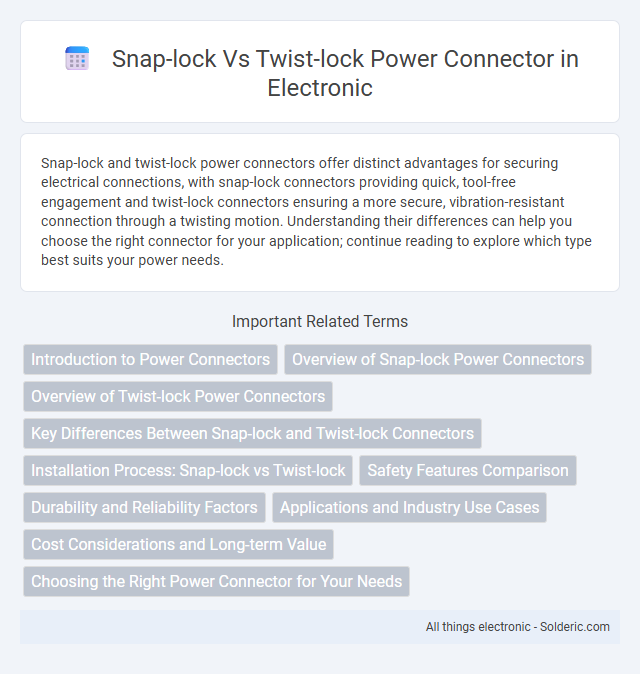Snap-lock and twist-lock power connectors offer distinct advantages for securing electrical connections, with snap-lock connectors providing quick, tool-free engagement and twist-lock connectors ensuring a more secure, vibration-resistant connection through a twisting motion. Understanding their differences can help you choose the right connector for your application; continue reading to explore which type best suits your power needs.
Comparison Table
| Feature | Snap-Lock Power Connector | Twist-Lock Power Connector |
|---|---|---|
| Connection Mechanism | Snaps into place with spring-loaded locking tabs | Requires a twist motion to lock securely |
| Security | Moderate locking security, can disengage under tension | High locking security, resists accidental disconnection |
| Use Case | Temporary or quick-connect power applications | Industrial, heavy-duty, and critical power connections |
| Durability | Less durable under mechanical stress | Designed for frequent connect/disconnect and rugged use |
| Installation Speed | Fast and easy to connect/disconnect | Requires additional twist step, slightly slower |
| Standards Compliance | Varies; often proprietary or specific to manufacturer | Meets IEC and NEMA twist-lock standards |
Introduction to Power Connectors
Snap-lock and Twist-lock power connectors are essential for ensuring secure electrical connections in industrial and commercial applications. Snap-lock connectors provide quick, tool-free engagement, making them ideal for situations requiring frequent disconnections and reconnections. Twist-lock connectors offer enhanced safety by preventing accidental unplugging through a locking mechanism, making your power supply more reliable in demanding environments.
Overview of Snap-lock Power Connectors
Snap-lock power connectors provide a secure, quick, and tool-free connection method ideal for various electrical applications requiring frequent disconnection. Their design features a locking mechanism that snaps into place, ensuring reliable contact and preventing accidental disconnection under vibration or movement. Your electrical installations benefit from enhanced safety and ease of maintenance with Snap-lock connectors compared to traditional Twist-lock counterparts.
Overview of Twist-lock Power Connectors
Twist-lock power connectors are designed for secure electrical connections in industrial and commercial applications, featuring a locking mechanism that prevents accidental disconnection. These connectors use a unique pin configuration that requires a twist motion to engage or disengage, ensuring a reliable and stable power supply. Commonly found in heavy machinery, construction sites, and temporary power setups, twist-lock connectors enhance safety and durability compared to standard plug designs.
Key Differences Between Snap-lock and Twist-lock Connectors
Snap-lock connectors provide a quick and easy push-to-connect mechanism ideal for applications requiring rapid installation and removal, while twist-lock connectors feature a locking design that requires twisting to secure the plug, ensuring a more stable and vibration-resistant connection. Snap-lock connectors are commonly used in residential and light commercial settings due to their user-friendly interface, whereas twist-lock connectors are preferred in industrial environments for their enhanced safety and durability under heavy loads. The key differences revolve around their locking mechanism, application suitability, and level of connection security.
Installation Process: Snap-lock vs Twist-lock
The installation process of snap-lock power connectors involves a simple push-and-click mechanism, enabling quick and tool-free attachment, which is ideal for rapid setups and frequent disconnections. Twist-lock connectors require alignment of prongs followed by a rotational twist to securely lock the plug in place, providing enhanced safety and preventing accidental disconnections in industrial and heavy-duty applications. Snap-lock connectors prioritize ease and speed, while twist-lock systems emphasize secure connections and durability under demanding conditions.
Safety Features Comparison
Snap-lock power connectors provide secure connections through a physical locking mechanism that prevents accidental disconnection and ensures stable electrical contact. Twist-lock connectors offer enhanced safety by requiring a rotational motion to engage and disengage, reducing the risk of unintentional unplugging and improving resistance to vibration and environmental stress. Both connectors incorporate insulating materials and robust design standards to minimize electrical shocks and short circuits, but twist-lock connectors generally deliver superior protection in industrial and high-vibration settings.
Durability and Reliability Factors
Snap-lock power connectors feature a robust design with secure locking mechanisms that resist accidental disconnections, offering high durability in environments with frequent vibrations or movements. Twist-lock connectors provide enhanced reliability through a twisting motion that ensures firm contact and prevents loosening under mechanical stress, ideal for industrial and outdoor applications. Your choice should consider the operating conditions, as snap-locks excel in quick assembly and disassembly, while twist-locks prioritize long-term connection stability and resistance to wear.
Applications and Industry Use Cases
Snap-lock power connectors are widely used in consumer electronics and residential lighting systems due to their quick-release mechanism and simplicity, making them ideal for applications requiring frequent connection changes. Twist-lock power connectors dominate industrial and commercial settings such as construction sites, manufacturing plants, and data centers, offering secure and reliable connections that prevent accidental disconnection under heavy load or vibration conditions. Both connector types cater to distinct industry needs, with snap-lock favored for ease of use and twist-lock prioritized for safety and durability in demanding environments.
Cost Considerations and Long-term Value
Snap-lock power connectors generally offer lower upfront costs due to simpler design and manufacturing processes, making them cost-effective for projects with tight budgets. Twist-lock connectors, despite higher initial investment, provide superior durability and secure connections that reduce maintenance expenses and downtime over time. Evaluating total cost of ownership favors twist-lock connectors in applications demanding long-term reliability and safety compliance.
Choosing the Right Power Connector for Your Needs
Choosing the right power connector for your needs involves understanding the differences between Snap-lock and Twist-lock designs. Snap-lock connectors offer quick and easy connections with a simple push-to-lock mechanism ideal for low frequency plug-ins, while Twist-lock connectors provide a secure, twist-to-lock system commonly used in industrial settings where safety and durability are critical. Your choice should prioritize the application's voltage requirements, environmental conditions, and the necessity for secure engagement to ensure optimal performance and safety.
Snap-lock vs Twist-lock power connector Infographic

 solderic.com
solderic.com